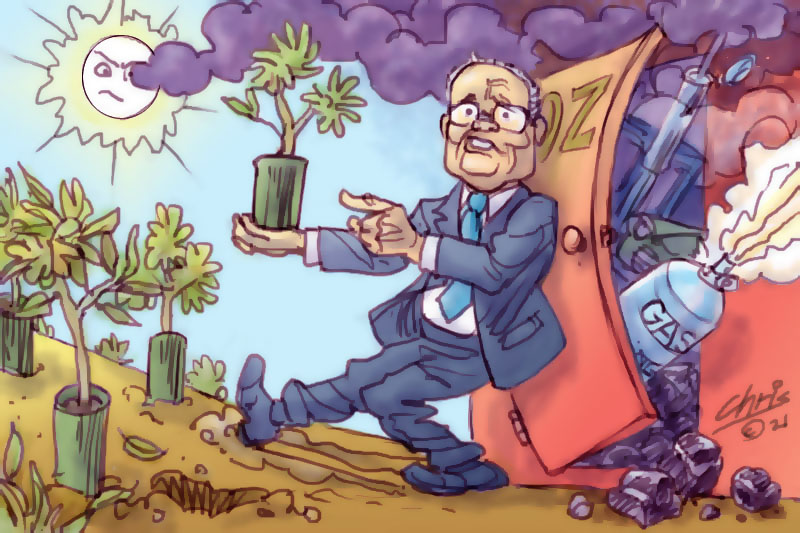- Greg Foyster
- 18 October 2021
In July this year the UN ranked Australia dead last out for climate action out of more than 170 countries surveyed. Yes, our federal government’s climate policies are literally the worst in the world. But while Australia is a global laggard in reducing pollution, we’re something of a leader in covering up this failure and getting away with it.
The history of Aussie climate spin goes back to an earlier climate agreement called the Kyoto Protocol. At the last minute, the Howard government negotiated to allow emissions from land use changes — essentially deforestation — to be counted in the baseline year, 1990.
Why? Because there was a lot of deforestation in Australia in 1990, and emissions from land use spiked. Against that artificially high baseline, emissions in future years were bound to look pretty good. As a result, we were able to keep increasing our pollution from burning coal, gas and oil, and then boast about meeting a target that was ludicrous in the first place.
Makes you proud, don’t it? This dodgy accounting trick was later dubbed the ‘Australia clause’, and has set the tone for Australia’s role in UN climate negotiations ever since.
So as the Morrison government prepares to head to the UN climate talks in Glasgow, what other world-class sneakiness do they have in store? And what do all those percentage targets being bandied about mean anyway? Here’s a short guide to prepare you for this week’s spin in advance.
'Don’t believe any arguments about little old Australia being too small to make a difference. Australia is actually the world’s largest exporter of LNG and one of the top two exporters of coal.'
Net zero is a distraction
First, the whole debate about net zero by 2050 is a political sideshow. Nearly every country in the world, plus all the Australian states and territories, have already signed up to this goal. It’s a given the federal government will too. But the federal Coalition is deliberately having a loud, public debate about a distant target so they don’t have to talk about taking action in the immediate term.
2030 trickery
What really matters is the next decade. This is the main game for COP26 in Glasgow — world leaders are being urged to update their pledges for how quickly they can cut emissions by 2030.
Australia still had the target Tony Abbott set years ago — cutting emissions by 26-28 per cent by 2030. At the time, the Coalition government argued this was in step with what the US was doing. Now the US has moved on, aiming for emissions cuts of 50-52 per cent by 2030. Most of Australia’s important international allies have also adopted this range or better. The UK’s conservative Prime Minister Boris Johnston, for example, has pledged to cut emissions by 68 per cent by 2030.
Not only is Australia’s target out of step with other developed nations, it’s actually even worse than it first appears. That’s because our 26-28 per cent target includes emissions cuts from avoiding deforestation or changes to land use. Reducing emissions from land use is legitimate but, as Climate Action Tracker explains, this sector has ‘been used by governments to obscure a lack of progress in reducing fossil fuel emissions’. Once land use change is removed from our target, Australia is actually only aiming to cut emissions by 11-15 per cent by 2030.
Piggybacking off the states
As a Prime Minister, Scott Morrison’s instinct has been to do the bare minimum required to alleviate public pressure. So if the Coalition does decide to increase Australia’s 2030 climate target — and it’s a big if — the question he will probably ask himself is: what’s the smallest increase I can get away with?
In this case, the bare minimum is to commit to what Australia will achieve anyway without any federal help. Last week ClimateWorks added up existing emissions reductions commitments from state governments and found they equate to a de-facto target of 37-42 per cent by 2030.
Rumours circulating in the press hint that the federal government might say Australia is on track for this sort of range, without actually committing to a new target. Whatever the case, remember that the Morrison government is really just claiming credit for the hard work of state governments.
The Technology Roadmap to nowhere
As part of their climate announcement, the Morrison government is likely to release an update to their Technology Investment Roadmap, which sets out policies to reduce the costs of particular technologies. Unfortunately many of the technologies chosen aren’t truly clean or zero emissions — they include carbon capture and storage (CCS) and hydrogen produced with fossil fuels. There’s no renewable energy in there, no assessment of how emissions can be reduced and no pathway to reach our 2030 target.
Cooking the climate with gas
Gas is a dirty, leaky fuel and shouldn’t be considered a major part of the clean energy transition. But over the next few months Energy Minister Angus Taylor will probably be spruiking it as a kind of ‘bridging fuel’ in between coal and renewables. This is very outdated thinking because any new gas infrastructure we build now is likely to lock in more pollution for decades.
Last week, News Corp’s new ‘Mission Zero’ series included an explainer on the pros and cons of gas that failed to mention the key climate concern: gas is mostly composed of methane, which has a global warming effect 86 times higher than carbon dioxide over a 20 year period. In fact, the latest IPCC report revealed that methane is already responsible for 0.5 degrees of current warming. Research in Australia has found this methane leakage may be much higher than assumed, which makes the government’s so-called ‘gas-fired recovery’ look like a climate disaster.
The International Energy Agency’s Net Zero by 2050 Roadmap recommends no new gas fields approved for development after 2021. This is necessary to have a 50 per cent chance of limiting global warming to 1.5 degrees by 2100.
Exporting pollution to the world
Don’t believe any arguments about little old Australia being too small to make a difference. Australia is actually the world’s largest exporter of LNG and one of the top two exporters of coal. That makes us the third-largest exporter of carbon pollution embedded in fossil fuels, behind only Russia and Saudi Arabia.
If these exports are taken into account, Australia is responsible for up to 5 per cent of global greenhouse gas emissions. And if future fossil fuel developments go ahead, including the Adani coal mine in the Galilee Basin, then Australia could be linked to up to 17 per cent of world carbon pollution.
If you keep these things in mind, you might make it through the week without falling for one of the federal Coalition’s cunning climate tricks. Good luck.

 Greg Foyster is a writer, illustrator and author of the memoir Changing Gears. His non-fiction and cartoons have appeared in The Age, The Saturday Paper, ABC, Meanjin, Eureka Street and others. His fiction has appeared in The Big Issue, Aurealis and Overland. He currently works in communications for an environment charity.
Greg Foyster is a writer, illustrator and author of the memoir Changing Gears. His non-fiction and cartoons have appeared in The Age, The Saturday Paper, ABC, Meanjin, Eureka Street and others. His fiction has appeared in The Big Issue, Aurealis and Overland. He currently works in communications for an environment charity.
No comments:
Post a Comment